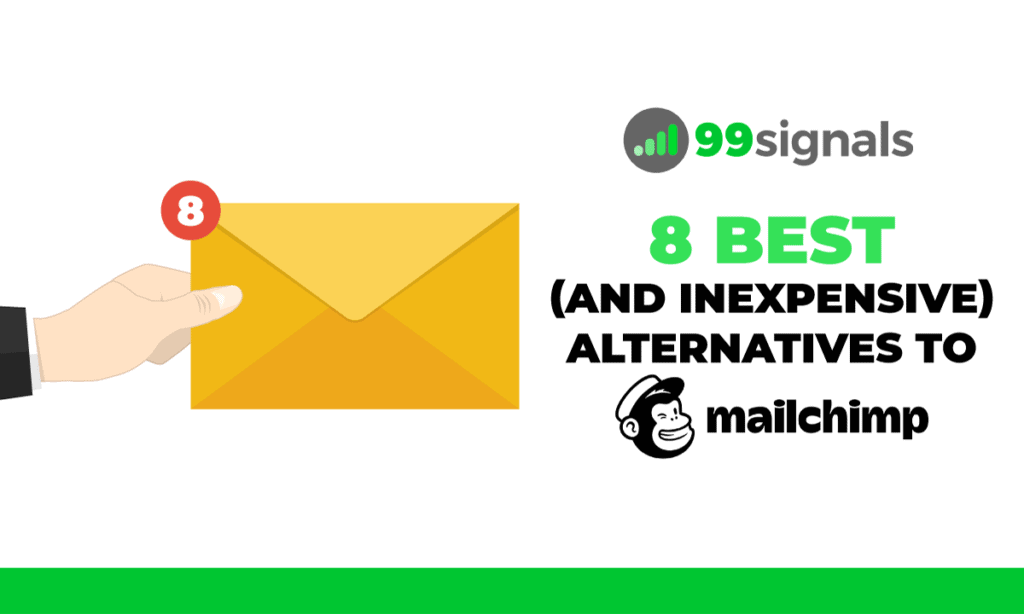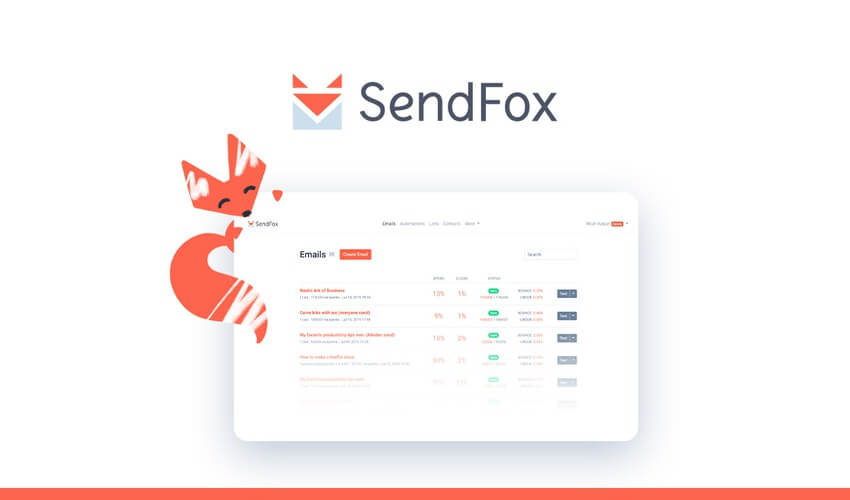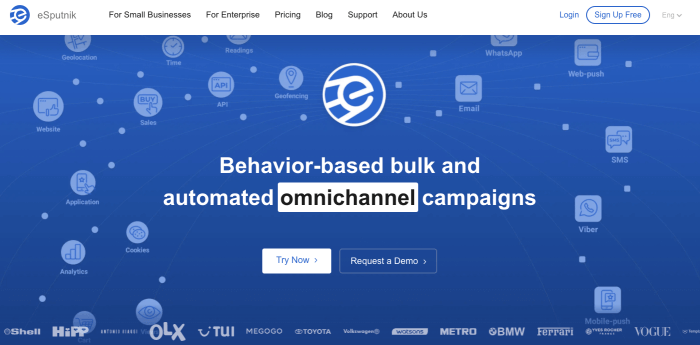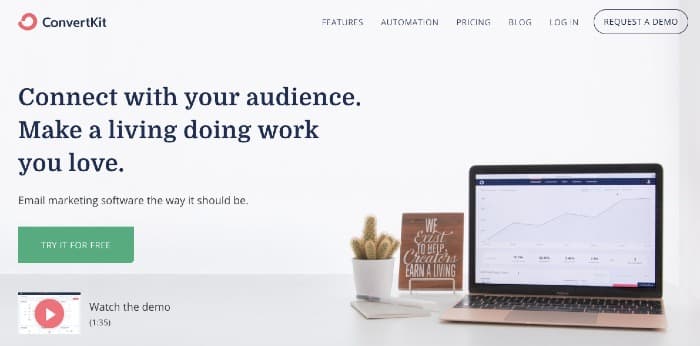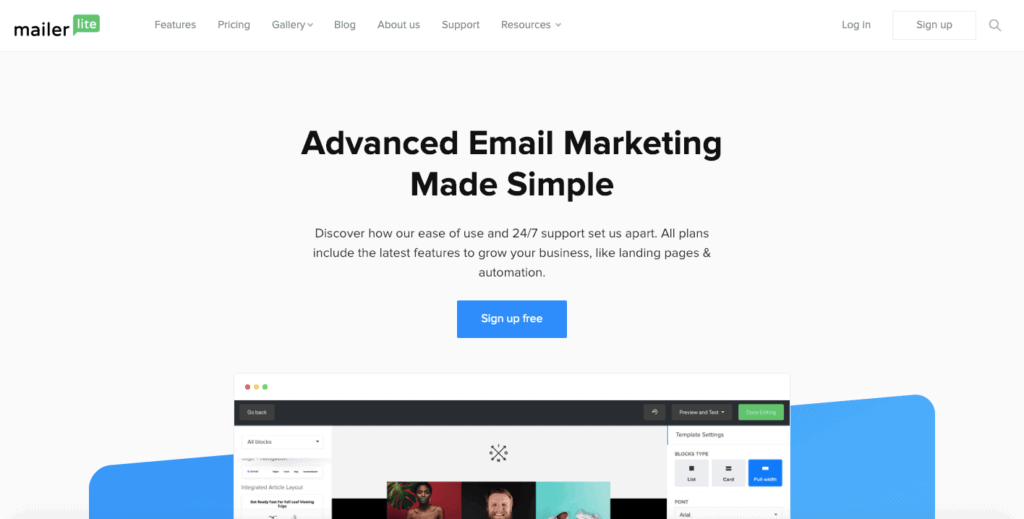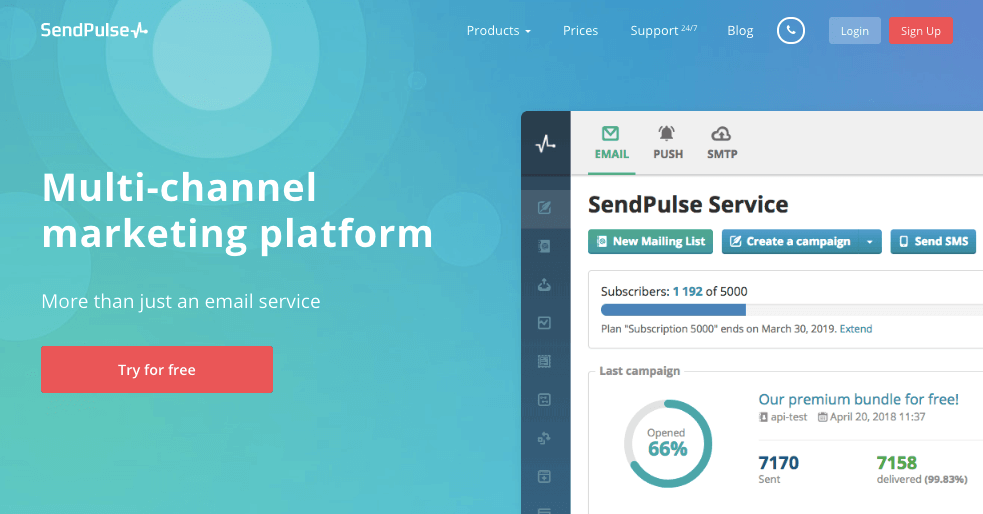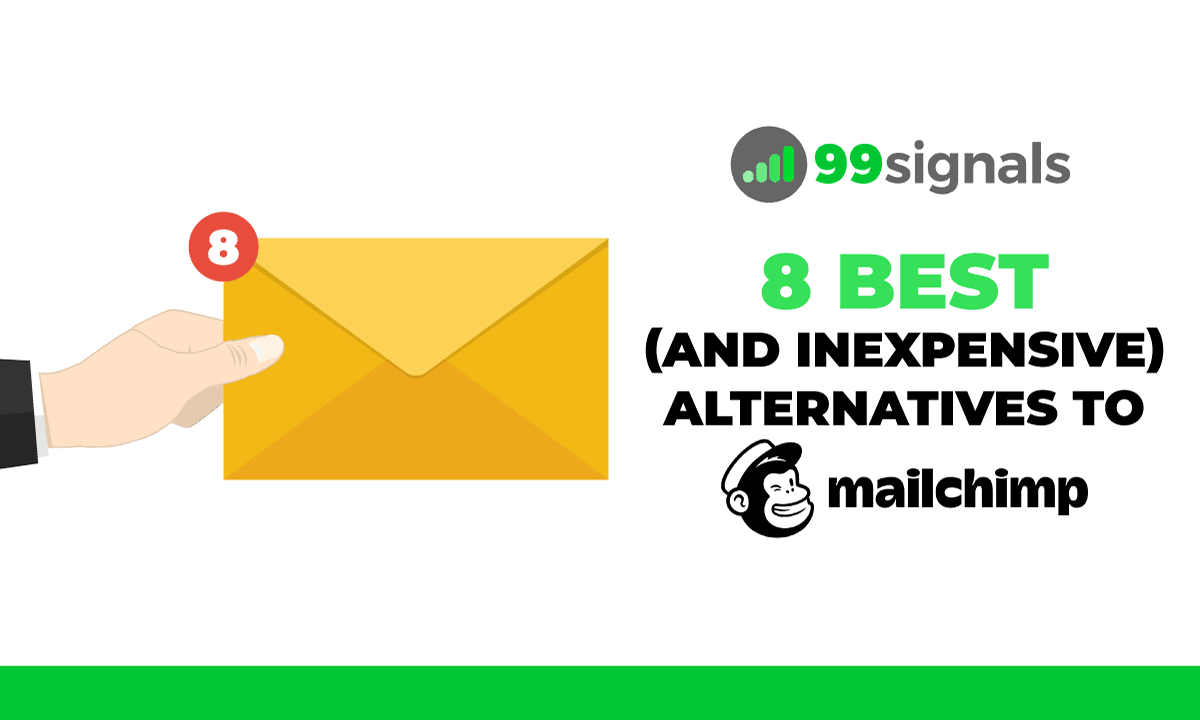When I was seeking a reliable email marketing service for my digital marketing agency, Mailchimp seemed like the best option. It had a stellar reputation and most marketers I knew were using it at the time for their email marketing needs. Furthermore, Mailchimp was one of the few email marketing services that offered a forever free plan, wherein you were allowed to send 12,000 emails to 2,000 subscribers in a month. At the time, my agency blog had less than 500 followers, so it was an easy decision to make. I created my free account with Mailchimp and kickstarted my email marketing journey. A few months later, I started 99signals as a side project to document all the strategies and tactics I was using to grow my agency business. A few posts started performing well in search results and with the help of an in-depth guide on link building, my email list grew from a mere hundred to over 2,000 subscribers. My email list had outgrown Mailchimp’s forever free plan. Up until that time, I was content with Mailchimp’s free plan. It was only when I crossed the limit and started paying the ever-escalating monthly bills, that I realized that my favorite email marketing software had limitations. It was only when I noticed these chinks in the armor that I started considering Mailchimp alternatives. But before I reveal these alternatives, let’s get one thing straight — I’m not suggesting that Mailchimp is not a good email marketing tool. On the contrary, Mailchimp is a phenomenally useful tool, packed with features most marketers and bloggers will find extremely valuable in their quest to engage their followers. It is the preferred email marketing service provider (ESP) for several businesses and bloggers worldwide. And from a market share standpoint, Mailchimp has no competitors. It commands a market share of over 60% in the email marketing space, dwarfing all the other major players in the segment. That said, it’s not the best email marketing service for every business and blogger out there.
3 Reasons Why You Need to Consider Mailchimp Alternatives
From my own personal experience, I found 3 main reasons why Mailchimp alternatives are worth considering:
3 Reasons Why You Need to Consider Mailchimp Alternatives8 Best Mailchimp Alternatives1. Sendinblue2. Omnisend3. SendFox4. HubSpot5. eSputnik6. ConvertKit7. MailerLite8. SendPulseFinal Thoughts on Mailchimp Alternatives
1. Steep Learning Curve
One of the most common complaints users have about Mailchimp is that it has a steep learning curve. For someone who’s new to email marketing, the interface can seem convoluted and it can definitely take a while before you zero-in on the perfect email template for your business. It’s definitely not a beginner-friendly tool and it’ll take time before you master all the features within the tool.
2. The Limitations of the Forever Free Plan
Mailchimp is widely known for its forever free plan. It’s perhaps the best “freemium” plan at the moment (second only to Sendinblue’s forever free plan). But it’s not without its limitations. As discussed earlier, the free plan allows you to send only up to 12,000 emails per month to up to 2,000 subscribers. Once you cross that limit, you need to upgrade to one of their paid plans. Furthermore, some of Mailchimp’s best features are not available under the free plan, including my favorite Mailchimp feature — Send Time Optimization. Send Time Optimization uses data science to determine when your subscribers are most likely to engage, and sends your emails at that time. You no longer have to worry about the right time to send your emails. Unfortunately, in order to use Send Time Optimization, you’ll need to upgrade to one of their paid plans. [Side note: Check out this resource for a more detailed take on Mailchimp pricing]
3. Lack of Customer Support
I judge brands by the quality of their customer support. Sadly, Mailchimp’s customer support leaves a lot to be desired. If you’re on the forever free plan, there is no email and chat support. You’ll have to rely on their knowledge base to learn the nitty-gritties of email marketing. Mailchimp cites cost control as the reason for not providing adequate customer service which I find really strange for a brand that commands over 60% market share in the ESP space. Most of the Mailchimp competitors featured below provide exceptional customer service. If you’re reading this article, you are likely seeking an alternative service to Mailchimp and perhaps you have your own reasons for doing so. You’ve come to the right place. In this article, I’ll reveal 8 of the best Mailchimp alternatives and explore some of their key features and pricing plans.
8 Best Mailchimp Alternatives
1. Sendinblue
Sendinblue started as a digital marketing agency and then evolved into an email marketing platform in 2012. The company’s email solutions are tailored mostly towards small businesses. From its beginner-friendly interface to pricing plans to features, everything in Sendinblue is designed keeping small businesses in mind. The Sendinblue free plan allows you to send 300 emails per day. You can add unlimited contacts in your email list under the free plan and it also includes email automation features. Key features – Some of Sendinblue’s key features include a mobile-friendly email designer, an extensive email template library, workflow editor, customizable sign up forms, and real-time reporting. Pricing – Unlike other email marketing services in this list, Sendinblue doesn’t offer list-based plans. Instead, you get to choose a plan based on the number of emails you’d like to send per month.
Free – $0/mo (300 emails/day) Lite – $25/mo (40,000 emails /mo) Essential – $39/mo (60,000 emails/mo) Premium – $66/mo (120,000 emails/mo) Enterprise – Custom
Click here to sign up for Sendinblue
2. Omnisend
If you’re in the eCommerce space and are looking to improve your omnichannel communication, Omnisend should be your first option. SMS automation, Facebook custom audiences, and Google remarketing lists are some of the most important features for advanced eCommerce marketing automation. If your business is growing and you’re seeking a great Mailchimp alternative for more advanced eCommerce marketing automation, you should seriously consider Omnisend. Key features – Omnisend will help to replace the many small, separate apps you’re currently using, allowing you to enjoy all you need in a single tool: different lead forms, landing pages, predefined marketing automation workflows (product abandonment, cart recovery), advanced visitors segmentation, and even SMS marketing. Pricing – The pricing model is based on subscribers and functions. There is a free plan to send 15,000 emails to up to 2000 subscribers. The Standard plan starts from $10 per month. Under PRO plan ($199/mo), you’ll get your own dedicated account manager. The Standard plan gives you automation workflows, standard segmentation, product import and recommendations, interactive email elements, and Google Customer Match sync.
Up to 500 subscribers – $10/month Up to 5000 subscribers – $50/month Up to 10,000 subscribers – $80/month Up to 50,000 subscribers – $240/month Up to 100,000 subscribers – $475/month
If you have a large email database, you can opt for the custom plan. The PRO plan gives you additional advanced segmentation features, SMS automation, personalized recommendations, UTM management, dedicated account manager, and custom IP address. The price of PRO plan starts from $199 per month.
Up to 10,000 subscribers – $199/month Up to 50,000 subscribers – $600/month Up to 100,000 subscribers – $1,190/month
Click here to sign up for Omnisend
3. SendFox
Launched in November 2019 by serial entrepreneur Noah Kagan (founder of AppSumo and KingSumo), SendFox is an email marketing tool designed specifically for content creators. SendFox was created as a solution to the email marketing problem that Noah and his team were facing at AppSumo. He was frustrated with all the existing ESPs, including Mailchimp, and he wanted to launch an email marketing service that was easy to use, but at the same time, quite affordable. To be honest, when I reviewed SendFox back in November 2019, I found it lacking several key features. Since then, SendFox has worked on adding some new features, but there’s definitely room for improvement. I’d like to see more email templates, automation triggers, and font types added to the mix. I wouldn’t include SendFox in the same league as other Mailchimp alternatives like Sendinblue and ConvertKit, but if you’re on a shoestring budget and tired of the restrictions with Mailchimp’s free plan, then you should definitely try SendFox. Key features – Some of SendFox’s unique features include custom landing pages and forms, integrated RSS functionality, and auto-import from Mailchimp — a cool feature that allows you to easily import all your contacts from Mailchimp to SendFox. To learn more about SendFox’s key features and functionalities, you can watch my in-depth review and walkthrough below or read the accompanying article here.
Pricing – SendFox offers a free plan and a lifetime plan that’s currently live at AppSumo. You can get lifetime access to SendFox for just $49 and send up to 50,000 emails per month. This deal has been live at AppSumo since October 2019. But since this is AppSumo’s very own email marketing tool, you can expect it to be live for a longer duration than some of the other deals on AppSumo. Because of the lifetime access deal on AppSumo, SendFox is currently the most affordable email marketing tool on the market. Side note: If you’d like to increase your monthly email sends and remove the SendFox branding from your emails, you’ll need to opt for the Empire Add-on plan which is $10/mo + $10 for each additional 20k sends. Get lifetime access to SendFox for just $49
4. HubSpot
HubSpot provides a plethora of inbound marketing tools aimed primarily at small businesses and marketing agencies. Some of these tools follow a freemium model and some are 100% free with no strings attached. Take HubSpot’s Blog Ideas Generator, for instance. HubSpot’s email marketing tool, on the other hand, follows a freemium model. With this tool, you’re allowed to send 2,000 emails per month and manage five different email lists. As is the case with any other service that follows a freemium model, you’ll need to upgrade to one of HubSpot’s paid plans if you’d like to remove restrictions on your account and unlock advanced features. Key Features – The free email tool includes basic features such as campaign management, forms, contact management, and so on. More importantly, HubSpot’s email platform is powered with the free CRM tool, which means you get access to valuable contact insights, helping you deliver personalized emails to your subscribers. Pricing – As long as you stay within the send limit of 2,000 emails/month, HubSpot’s email platform is free to use. However, if you’d like to send more emails and access advanced features such as A/B Testing, Time Zone Sending, and Email Automation, you’ll need to upgrade to HubSpot’s flagship tool, the HubSpot Marketing Hub. The basic plan starts at $50/month, which also includes premium access to other HubSpot lead conversion tools like live chat, conversational bots, ad targeting, and more. Click here to sign up for HubSpot
5. eSputnik
eSputnik is a Ukraine-based marketing automation company that helps you set up multichannel campaigns via email, text, web push, and messengers easily and quickly. With eSputnik’s email editor, you can build scenarios for sending ready-made messages – when, to whom, where, and under what conditions. The other great thing about eSputnik is that the service doesn’t divide its users into basic and pro users like other ESPs normally do. The company adheres to its motto of making professional marketing easy and affordable. Key features – eSputnik’s drag-and-drop email editor is easy to use and allows you to create beautiful emails using blocks and structures. The Subject Line Assistant will help you optimize your subject lines and improve your email’s open rates. And with Send Time Optimization, you can send emails exactly at the moment when your subscribers are most likely to check and open their email. Other key features include email automation, A/B testing, email segment builder, campaign analysis, and real-time reporting. Pricing – Here are the current email pricing plans eSputnik offers:
Freedom – $1.99/1,000 messages (No subscription fee, unlimited contacts and emails) Optimal – $19/mo (up to 10,000 emails per month, unlimited contacts) Email Marketing Agency – $599/mo (eSputnik will take care of the entire email marketing and marketing automation complex for your business)
Click here to sign up for eSputnik
6. ConvertKit
ConvertKit is a preferred email marketing service of several professional bloggers, including Pat Flynn from Smart Passive Income. ConvertKit offers the same functionality and ease of use as other ESPs in this list, with one key difference: it’s tailored for bloggers. One of the most talked about features of ConvertKit is the automation rules that you can create with the tool. It’s based on a very simple “if this/then that” sequence. Key features – Some of the key features of ConvertKit include responsive opt-in forms, landing page creation, email automation, email broadcasts, and campaign reporting. It’s also integrated with popular services such as Shopify, WooCommerce, Zapier, SumoMe, etc. Pricing – The ConvertKit pricing is list-based. The biggest flip side is that there is no free trial available. However, when you sign up, there is an option for you to get the first month free. The basic email plan with 1000 subscribers starts from $29/month.
0–1k subscribers: $29/month 1k–3k subscribers: $49/month 3k–5k subscribers: $79/month For up to 8k subscribers: $99/month
Sign up for ConvertKit To learn more about ConvertKit, check out our in-depth ConvertKit review
7. MailerLite
MailerLite is an email marketing platform used by 560,000+ small businesses, entrepreneurs, bloggers, artists, authors, hobbyists, activists, dreamers, and anyone else who wants to build relationships with their audience. Their goal is to remove the complexity from email marketing with easy-to-use, yet powerful features and exceptional 24/7 customer support with real people always ready to help. MailerLite offers the same advanced tools and integrations of other Mailchimp alternatives, yet they manage to keep it simple, inexpensive and fun to use for people of all skill levels. Key Features – MailerLite’s drag & drop editor offers pre-designed blocks for social media, embedded surveys, and video to name a few. Landing pages, pop-ups, automation, and segmentation are all included in the plans. Pricing – MailerLite keeps pricing simple as well. While the free plan includes most of the features, all of their paid plans include unlimited emails with every feature.
Up to 1000 subscribers (limited features) – FREE Up to 1000 subscribers – $10/month Up to 2,500 subscribers – $15/month Up to 5,000 subscribers – $30/month Up to 10,000 subscribers – $50/month Up to 15,000 subscribers – $75/month Over 25,000 subscribers – $120/month
Click here to sign up for MailerLite
8. SendPulse
SendPulse is one of the new entrants in the market which seamlessly combines simplicity with complexity to offer an email marketing product that can rival Mailchimp and the other services featured in this article. It seeks to bring unique features and an easy learning curve to the email service provider (ESP) market, making it an ideal option for beginners. It’s also the only ESP among the four in this list that offers a free plan like Mailchimp. Under the free plan, you can send up to 15,000 emails per month to up to 2500 subscribers while having access to premium features such as web push and autoresponders. Key Features – SendPulse is an integrated solution that offers bulk email, bulk SMS messages and web push notifications, allowing you to combine all 3 in your communication campaign. No other ESP in this list offers that. You’ll also be able to send emails to people within your email list who haven’t yet opened your emails the first time through a feature called “Resend to unread”. In addition to these, you’ll also be able to use features such as autoresponders, responsive subscription forms, A/B testing, and email analytics. SendPulse is integrated with 500+ services which include Zapier, WordPress, WooCommerce, Typeform, etc. Pricing – SendPulse offers both list-based and pay-as-you-go plans. List-Based Plans
Up to 2500 subscribers – Free (Limit – 15000 emails/month) 2500 subscribers – $9.85/month 3000 subscribers – $29/month 4000 subscribers – $32/month 5000 subscribers – $35/month 10000 subscribers – $53/month 25000 subscribers – $108/month
Pay-as-you-go Plans If you don’t send too many emails, SendPulse’s prepaid email packages give you the option to pay only for the emails you need.
10000 emails – $32 25000 emails – $70 50000 emails– $125 100000 emails– $212 250000 emails – $440 500000 emails– $812
Apart from these plans, there is also a VIP plan if you have more than 1 million subscribers. You’d have to reach out to the sales team to sign up for this plan. Sign up for SendPulse —> SendPulse Free Plan Check out our detailed review of SendPulse in this article here
Final Thoughts on Mailchimp Alternatives
So these are eight of the best alternatives to Mailchimp you should consider in 2020. If you have a preferred email marketing service that you think is a better alternative to Mailchimp than the ones listed here, please feel free to mention them in the comments section. I’d love to hear your thoughts. Editor’s Note: This article was first published on 24 Aug 2016 and has been updated regularly since then for relevance and comprehensiveness. An earlier iteration of this post had Newsletter2Go at #5, instead of SendFox. Newsletter2Go has since been acquired by Sendinblue (see #1). If you liked this article, you may also like:
Sendinblue vs Mailchimp vs ConvertKit: Email Marketing Tools Showdown 5 Best Blogger Outreach Tools to Find and Connect with Top Influencers 6 Best Email Marketing Tools for Small Businesses
